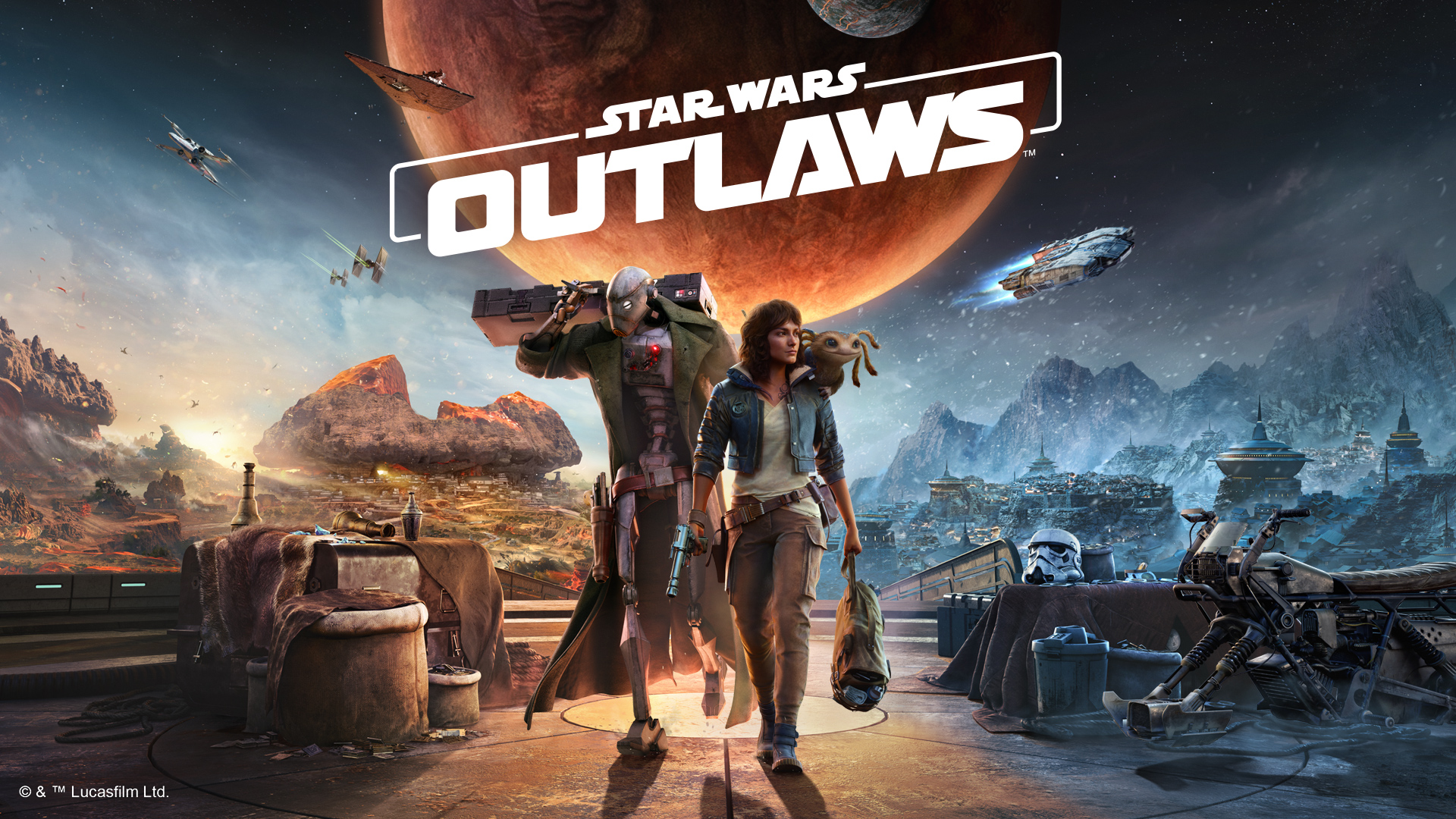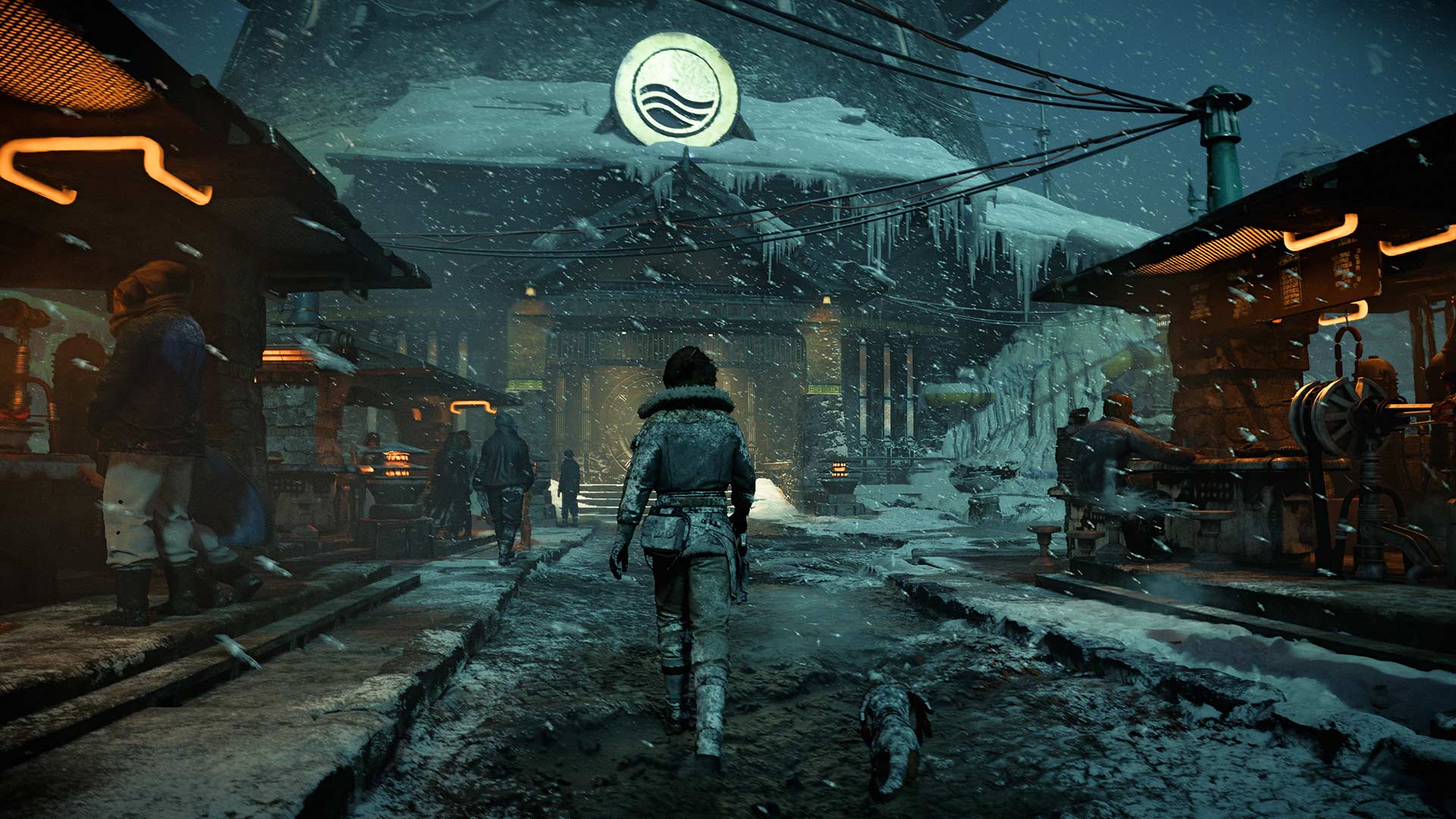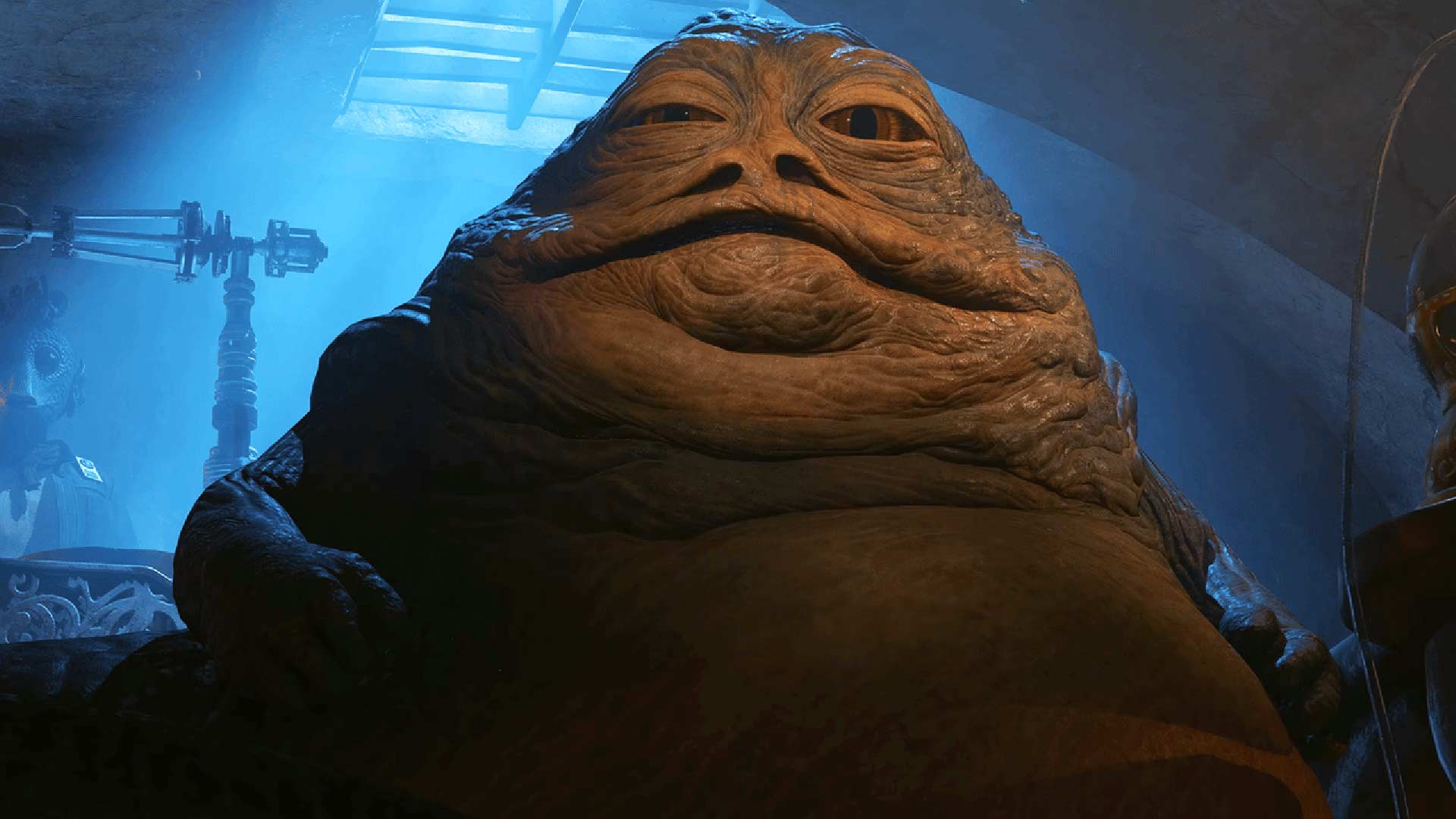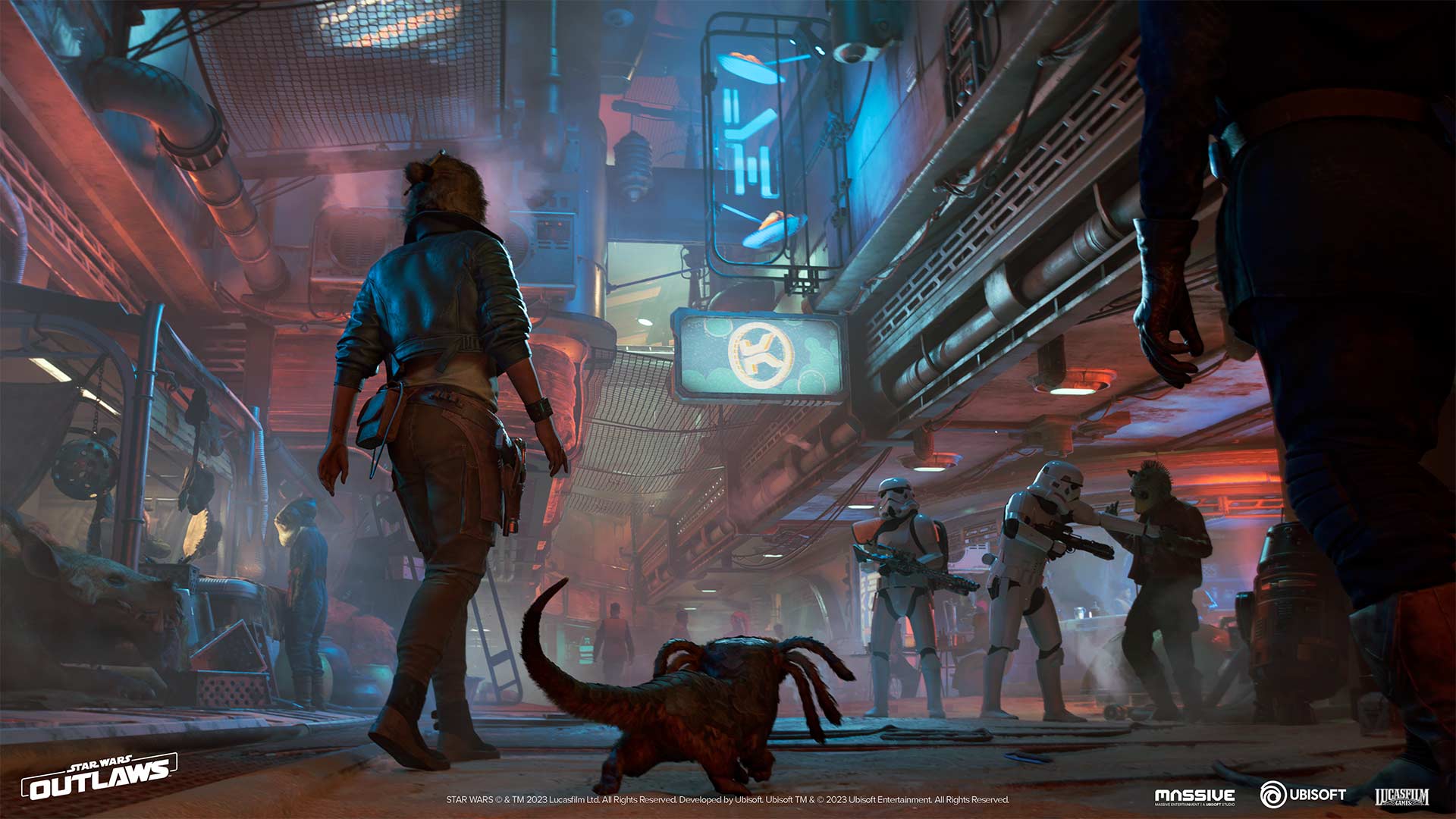
Of the many games that publishing giant Ubisoft has released over the years, Star Wars Outlaws is certainly one of the most unique.
On top of being set in the beloved galaxy far, far away, it’s also the series’ first-ever truly open-world experience — and it’s centred around a scoundrel Kay Vess (Venezuelan-Canadian Humberly González), not a lightsaber-wielding Jedi, to boot. What’s more, it’s an impressive international collaboration between lead developer Massive Entertainment (The Division) and Canada’s own Ubisoft Toronto (Far Cry 6), with the key narrative team being based out of the latter studio.
To learn more about this ambitious project, MobileSyrup sat down with Massive Entertainment game director Mathias Karlson and Ubisoft Toronto narrative director Navid Khavari at Ubisoft Forward in Los Angeles. Together, the pair discusses exploring new sides of the Star Wars universe, its balanced approach to fan service and the partnership between the Swedish and Canadian teams.
Your main characters are a scoundrel, cute alien and droid in Kay, Nix and ND-5. How are you offering a unique take on these classic Star Wars archetypes?
Navid Khavari: I think it goes back to when we first began with the idea of the scoundrel archetype itself. And that could take a whole lot of forms in Star Wars. But when we talk to Lucasfilm Games about this era between Empire Strikes Back and Return of the Jedi, we felt like we’d sort of seen the Jedi, we’d seen sort of the rebellion perspective, but we hadn’t seen as much the underworld perspective from the ground with all these events that are happening above. And I think what drove us was this kind of diversity of perspective. So you have Kay growing up on the streets of Canto Bight unable to trust anybody, couldn’t care less about a rebellion or wanting to get mixed up in a rebellion, and is just looking to land a score and survive. And then you have Nix, her companion, who is really the only crack in her armour. Everything for her is “me, I don’t trust anybody.” But then she’s got this pet next to her that is this little crack and like, ‘Okay, hold on, though, you do care.” And then you couple that with ND-5, which adds a whole other dimension. This is a BX commando droid from The Clone Wars who has seen such incredible violent warfare and now has journeyed as part of the underworld, and been, not in a friendly way, forced to work with Kay. So we feel it’s a unique series of perspectives that when you throw them together, I think is really bringing something new to Star Wars itself.
You have some familiar planets, like Tatooine, and then some new ones, like the moon of Toshara. How did you decide on which sorts of planets to include and how they will add to Kay’s journey from both a narrative and gameplay perspective?
Khavari: I think on the narrative side, we were always looking at the journey, and the story is an engine to push you through the galaxy, through the Outer Rim, through these planets. And I think that was part of it — what actually logically makes sense on this sort of heist adventure. But sometimes in the films, you [only] got tastes of these places. So for example, Kijimi, this snowy ice planet, you’re there only so briefly in Rise of Skywalker, but there’s so much possibility. And so we saw an opportunity there, where we could say, ‘Hey, what if we expanded this out? What if we had a whole new syndicate that’s in charge of it in the underworld that has this hierarchical structure, and they’re these Melitto-type insects. Similarly with Akiva, as a planet — it’s only been in the books. We’ve never seen this jungle planet come to life.
So there was the journey aspect of it. But then there was also, what kind of new biomes can we flesh out in the Star Wars universe, all under this sort of guiding principle of ‘People have been asking for this game since they were six.’ I know I have. What is exciting to step into Star Wars? What are the things that are gonna draw you in?
Mathias Karlson: When we started from the point that we’re making a Star Wars open-world game, what does that mean, truly? If we’re really, truly, authentic to that fantasy, it can’t just be a planet surface. It needs to include space, because Star Wars space is as important as its planets. And this is a multiplanetary journey, so [it’s about] being able to stitch that all together seamlessly into what feels like one slice of the galaxy where you have full freedom. Of course, there’s a roller coaster ride adventure driven by the story, but that’s an engine, and it has a lot of stations, that train, where it naturally stops for you to just enjoy this rather than exploring on your own accord. And giving you that range of gameplay experience — from the very small, sitting at a Sabacc table, playing cards, walking up the street, getting on your speeder and driving to your ship, taking off, maybe ending up in a few gunfights, ambushed by pirates and then jumping somewhere else — it’s something we’re very proud of and think people will enjoy as much as we did.
With some Star Wars media, there can be an inclination to rely heavily on fan service and include a lot of recognizable characters. You have some of those, but you’re still telling an original story. How do you balance including familiar faces like Lando and Jabba while also having the story still focused on Kay and not falling back on a ‘Kay is related to Han Solo’ sort of thing?
Khavari: [laughs] I see what you’re doing. No, I’m kidding! I think it’s a really great question.
When you join a Star Wars project, it’s like, ‘Wow, this is Star Wars.’ There is often that fan side, but you have to put it on a shelf. You have to say, ‘Okay, yes, that that exists, but what is Star Wars, really?” Especially in this era, it’s high stakes, emotional tension, a bit of lighthearted humour, but it’s [about] characters that grow and change and have heart and meaning. And so that was really our guiding light. We were very, very aware that this is a game and story that, just as when Star Wars came out in ’77 was able to draw so many people that weren’t even aware of sci-fi or space operas into the fold, we want to do the same thing. And so while there are key characters like Qi’ra [from Solo: A Star Wars Story] or Jabba or Lando who absolutely play a part, the sort of easter eggs, the depth, the world — all those things are incredibly important in terms of how much “Star Wars” there is. But it’s in service to character, and it’s in service to Kay’s journey. And I know that’s incredibly important to Lucasfilm Games, and it’s important to us. Because we want players to be able to pick up the controller whether they know Star Wars or not dive into Kay’s journey and say, “Hey, this is someone who has a target on her back and needs to land a score in order to survive.” You can take the Star Wars out of that and that’s still a relevant story and a relatable story. That’s our whole approach.
What does it mean for this to be the first true open-world Star Wars game? How do you take the Star Wars world and create tailored sidequests and miscellaneous activities that fit in that world?
Karlson: It all starts with what we call “stepping into Star Wars” internally. It’s just being in this world, walking in it, driving in it, flying in it. It really needs to feel authentically like this universe you’ve been seeing on the [big] screen or you’ve been playing in other games, but where you have the freedom to scratch the surface and poke at it and realize this is not a movie set, it’s not an authored ride, I’m here. And that is really the bedrock and something that’s very close to us as a studio — to breathe a lot of handcrafted detail and love and just this lived-in feeling into worlds.
And then, of course, it’s about filling it with substance — things that you can pursue with intent but also just become curious and say, “Oh, what’s that? I’m gonna go check it out,” and there’s actually something there. I think the few things that are really, really key is that the “free-form, open-world, play-it-on-your-own-terms” experience — that’s so central to the story about Kay Vess and her journey through the underworld in this era of Imperial power. So having the syndicates present and your actions having consequences and your choices matter, was really, really key when we thought about the open-world as well. So you will come across them and you might have to react on the spot and take a stance on “is it A or B, is it wrong or right?” And you might be in pursuit of something that you identify — like “you know what, the Pikes have this thing I really want and I’m going to find a way to get on their good side to get it.” And the ebb and flow of the reputation system with the wanted system linked to the Empire — if you break the space cops rules, they’ll come after you — was really key to bring both fun and variety, but also something that feels really natural and just immersive and authentic to the era and the fantasy.
The last thing I would highlight — not meaning the last thing to experience, but something we’re very excited about — is what we shared at Ubisoft Forward, which is the Experts. And that is our approach: really world anchor the journey of unlocking new equipment and abilities for Kay, where a lot of them are bound to these experts and from the beginning of the game, you don’t even know exist. And then you get clues of where they are, and you get little chains of intel, as we call it, to define them, journey to them. They’re fully-fledged characters with stories and little adventures associated with them that you have to go on to then unlock these little avenues of progression that in themselves ask you to engage with the world in different ways. So it’s really about bringing different lenses to you as a player to look at the world and engage with the world in different ways depending on what you’re after.
Navid, I don’t think a lot of people realize how many games are made in Canada, and that’s something I’m always trying to promote and that’s resonated with developers here. Even when I tell people this new Star Wars game is being made in Canada, they say they had no idea. From your perspective, what can be done to promote this sort of thing more?
🍁 Some of our #UbiTO members are helping create an out-of-this-galaxy gaming experience!
🌌 Get ready to explore the open world of #StarWars like never before ✨
👀 Read the full @mobilesyrup article about key Canadians behind #StarWarsOutlawshttps://t.co/K95YgFy5Kl pic.twitter.com/Dohqcwuine
— Ubisoft Toronto (@UbisoftToronto) June 14, 2023
Khavari: Yeah, we have a wonderful team — a lot of the story team is based in Ubisoft Toronto, and we’ve been developing this with our partners at Massive for years. We have a lot of great animators as well within that studio, and folks from Ubisoft Montreal that have been contributing. All of the cinematics that we’ve shot have been in studios within Ubisoft Toronto, and Ubisoft Montreal. So there’s absolutely just a huge wellspring of talent from Canada that’s been contributing to the game and giving some of that Canadian spirit and flavour, I think, to it. And it’s a beautiful thing with Ubisoft as well that we’re able to do that — that we’re able to work together across an entire ocean and it still feels cohesive. And I think it’s to the studio’s credit, to the talent we have across Canada, to be honest, that I think we’re able to hit the quality of bringing a Star Wars open-world game to life.
I’ve spoken to co-development studios in Canada and Europe and they’ve talked about a sort of cultural crossover, like a shared love of hockey. So, I’m curious: what was the collaboration like between Massive and Toronto and did you find anything in common that you bonded over that you might not have expected?
Khavari: I know I was bringing maple syrup over there all the time. [laughs]
Karlson: And I feel like Sweden is the “Canada of Europe.”
Everyone: [laughs]
Khavari: It’s going to sound corny, but it’s a shared love of games. That’s really, really universal. There’s a timezone difference but it’s really interesting because my mornings are so exciting when I get to have these calls with Massive and and I know that when we come together, it’s like the distance doesn’t matter. And I think that’s one thing that speaks to the generosity and spirit I think we all have. And it’s also a credit to Ubisoft as well. I think we have a great culture of collaboration within Ubisoft and we have co-development studios from around the world. And then speaking of Canadian influence — we worked together on The Division! [laughs] I actually spent about six months at Massive working on that game. And so, these relationships, while it might be like, “Okay, it’s great to work together on Star Wars Outlaws,” a lot of times they’re formed over the years. And I think that’s really something special about Ubisoft and especially with Massive and Ubisoft Toronto.
Karlson: I completely agree, and I also think Ubisoft is uniquely good and experienced when it comes to co-developing within the group. Like this game, we have many partner studios, ranging from all the way in North America to China, and many of them in Europe. And I think communication, but more than maybe anything, a really clear shared goal and passion for that goal. And I think in the case of this game, we just fell in love with it and knew what we were chasing from day one. And it’s been a very focused, almost single-minded journey to reach it together. And I think even though we did it through COVID, we’re so proud to be here today with a game that can fulfill that dream that we had.”
This interview has been edited for language and clarity.
Star Wars Outlaws will launch on PlayStation 5, Xbox Series X/S and PC on August 30th, 2024.
For more on the Canadian games featured in LA for Summer Game Fest and the cavalcade of related events, check out our comprehensive breakdown.
Image credit: Ubisoft
MobileSyrup may earn a commission from purchases made via our links, which helps fund the journalism we provide free on our website. These links do not influence our editorial content. Support us here.






